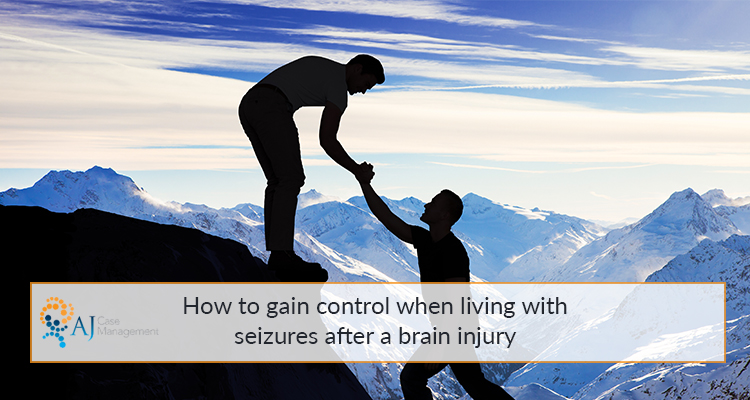Use this guide to find out detailed information about the seizures that can be experienced following a traumatic brain injury (TBI).
At AJ Case Management we created this blog to provide readers with educational insights into injuries, but more importantly the route to recovery and rehabilitation.
In this post you will find how seizures following a TBI aren’t barriers to you reaching your goals in life and how you can progress through rehabilitation with the right support.
Navigate through the contents below to find the topic you’d like to read about:
- Post traumatic seizure treatment and getting the support you need
- What happens in the brain during a seizure and what causes them?
- Post traumatic seizures vs post traumatic epilepsy – what is the difference?
- What happens before a seizure – the warning signs and symptoms of PTS
- What happens during a post traumatic seizure following a head injury?
- What happens after and the long-term effects of seizures on the brain
- What to do if you witness someone having a seizure
- Setting goals and achieving milestones after a traumatic brain injury
Post traumatic seizure treatment and getting the support you need
There isn’t one course of treatment for a brain injury as there are so many different types and many varying levels of severity.
Following a head injury you may be referred to a neuropsychologist who is professionally trained in the analysis, treatment and management of a brain injury. They will perform neurological assessments to detect any disorders that may have been caused by the brain injury.
Before, during and after the treatment it can be stressful, upsetting and confusing if you or a loved one has suffered a traumatic brain injury.
There is a lot that needs to be co-ordinated to aid the physical, mental and emotional recovery. A case manager can be the one person who arranges the rehabilitation and provides an individual care plan that is right for you.
A case manager is there to support you for the big milestones and in everyday life. From the litigation process, getting you back into education, learning how to communicate with family members, organising hospital appointments and much more.
Take a look at our ‘what is case management?’ page to find more examples of how a case manager can make the world of difference.
Following a traumatic brain injury, we will be there to support you in the long term, so you can reach your goals and build a bright future.
Get in touch with one of our expert advisors if you have any enquiries about how we can help you or a loved one.
What happens in the brain during a seizure and what causes them?
An injury or damage to the brain occurs when neurons (also known as brain cells) are damaged or destroyed.
Electrical and chemical signals pass through these neurons which is known as regular brain activity. Although these neurons come in many shapes and sizes, signals are passed from cell to cell in a systematic and organised way.
When the neurons are damaged through injury, this activity is interrupted and random electrical activity in the brain can take place. Here are the 3 groups that may be affected:
Sensory neurons – carries signals from the inside and the outside of the body to the central nervous system (CNS). For example, if you burnt your hand, the sensory neurons would tell the CNS that you just touched something very hot.
Motor neurons – carries signals from the CNS to the outer body, including organs, skin and muscles. For example, if you picked up something hot your motor neurons would be responsible for your muscles letting go of the hot item.
Interneurons – connect neurons in the central nervous system.
The erratic activity of these neurons can cause PTS following a TBI.
Although, PTS is not to be confused with post traumatic epilepsy (PTE). Although the symptoms can be similar, they are two separate conditions. Here’s a short explanation:
Source: www.khanacademy.org
Post traumatic seizures vs post traumatic epilepsy – what is the difference?
The biggest difference to note between PTS and PTE is that PTE is a chronic condition where seizures occur repeatedly.
PTS is a much broader term which simply refers to any kind of seizures that occur following a TBI. The amount or frequency of seizures is not defined in this condition.
A person with PTE will experience re-occurring seizures more than a week after the TBI.
It is estimated that PTE makes up around 5% of all epilepsy cases.
It is unpredictable as to who will develop these conditions after a brain injury, as it depends on the severity, placement and type of injury as well as the persons medical history.
These two conditions can be linked as PTS can lead to PTE and those who suffer from seizures after a brain injury are at a high risk of developing PTE.
However, it is important to remember that these neurological conditions are manageable and there are many treatments to keep seizures under control.
There are over 600,00 people living with epilepsy in the UK and 65 million worldwide. It is not a barrier to living a full life and there are many ways to feel supported when living with this condition. Your support system is there to help you set goals and achieve them, so you can reach the big milestones in your life.
Get in touch today to get support with the seizures and symptoms that may follow a traumatic brain injury.
Sources: en.wikipedia.org/wiki/Post-traumatic_epilepsy
en.wikipedia.org/wiki/Post-traumatic_seizure
The before, during and after a seizure…
What happens before a seizure – the warning signs and symptoms of PTS
The activity that happens in the brain during a seizure can be described as an ‘electrical storm’. This unpredictable activity can cause different symptoms and physical affects depending on which part of the brain is experiencing activity.
Some people experience warnings signs before they have a seizure, which are known as an ‘aura’. Although the person will still be conscious and aware of what is happening, it is known as the first stage of a seizure and is considered part of the process.
It is important to note that some people have no warning signs and seizures can be sudden and abrupt.
For those who do experience warning signs, the aura can be different for everyone and is often be hard to describe. It may be the same type of warning sign every time, which makes it easier to identify. Or, it may be different which makes it difficult to identify as an aura.
Common symptoms of seizure warnings signs can include…
Changes in senses
- Headaches, migraines or other pain
- Unfamiliar tastes, sounds or smells
- Affected vision
- Affected hearing
- Numbness or hypersensitive feelings
Changes in thoughts and feelings
- Pleasant, positive thoughts and happy feelings
- Rushing, anxious thoughts
- Strange feelings of confusion or panic
- Déjà vu
- Having strange thoughts about your body that something seems wrong
- An out of body feeling
Physical changes
- A dramatic change in temperature
- Increased heart rate
- Nausea
- Unsettled feelings in your stomach
- Looking ill or pale
- Feeling lightheaded or prone to faint
What happens during a post traumatic seizure following a head injury?
The middle phase of a seizure and everything that happens from the first symptoms to the end is called the ictal phase.
This is where the erratic electrical activity happens in the brain and takes action on the body. Common signs of the ictal phase can include:
- Loss of awareness (which some refer to as ‘blacking out’)
- Trouble with speaking and communication difficulties
- Hallucinations
- Breathing difficulties
- Loss of muscle control and jerk-like movements
- Body convulsions
- Memory loss
There are many other symptoms that can be experienced, some being physical and some that won’t be noticed by those around the person having the seizure.
If you suffer from seizures after a brain injury, you are not alone with your symptoms and there is plenty of support available to deal with them in everyday life.
What happens after and the long-term effects of seizures on the brain
The final stage is known as the postictal phase. This is where your brain works to stop the neurons irregular activity. The body tries to relax, enters the recovery period and starts to experience the aftereffects.
For some, recovery may begin as soon as the ictal phase has ended. Although, for others it can take minutes or hours to recover.
Common symptoms that may be experienced in the postictal phase can include:
- Feelings of confusion, fear or anxiety
- Fatigue or tiredness
- Feelings of frustration or embarrassment
- Difficulty with motor skills
- Pain in muscles
- Weakness or feeling light headed
It is difficult to know the permanent damage seizures can have on the brain as research is ongoing and experimental studies haven’t yet provided solid evidence.
Depending on the type of seizure, severity, length and the genes of the person will depend on whether damage to brain cells has occurred.
Experts don’t yet fully understand the long-term effects of seizures on the brain and emphasis is put on the variation of individual cases.
Symptoms can be managed, and your goals can be reached when experiencing the effects of seizures after a TBI. With the right help, you can successfully build a bright future and make achievements to be incredibly proud of.
Millions of pounds are going into the research of seizures and epilepsy. Take a look at the research success Epilepsy Research is having in the UK today and their plans for the future.
What to do if you witness someone having a seizure
Whether you are a carer, nurse, case manager, friend or family member, it can be scary to see someone having a seizure following a traumatic brain injury.
The first thing to do is supress feelings of panic or anxiety and try stay calm. Here are some things you can do to help the situation:
- Try preventing the person from falling and injuring themselves. If they are stood up, carefully help them to lie on the floor.
- Once they are on the floor, place them on their side to avoid choking.
- Clear the area of any objects that may harm them or they may come into contact with.
- Cushion their head to help prevent an injury.
- Time the duration of the seizure as if it is over 5 minutes you will need to call an ambulance.
Avoid restricting their movement, putting anything in their mouth, moving them unless they are in danger or attempting to forcibly stop the seizure.
If your seizures are a result of a traumatic brain injury, you may feel upset, confused or afraid. Or if you know someone who is going through this, it can be very difficult time, especially if you don’t have the right support around you.
A case manager will create the best recovery plan for you and co-ordinate rehabilitation for a smooth recovery.
Source: www.epilepsy.org.uk/info/firstaid/what-to-do
Setting goals and achieving milestones after a traumatic brain injury
From the initial injury, diagnosis, through to rehabilitation and recovery, there are so many achievements to be proud of for those with a TBI.
Each stage of recovery is unknown and most likely scary for the person with the injury and those around them. But, you are not alone.
Rehabilitation is a collaboration, and no one should face the journey on their own. Setting clear goals will show you the accomplishments being reached throughout recovery.
Goals are relative and different for everyone. Whether it is going for a walk, coming home from the hospital or being able to give a family member a hug, we celebrate all achievements and support you in the long term.


Recent Comments